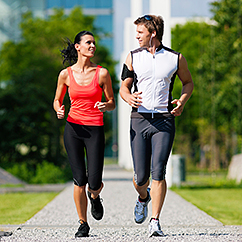Unfortunately, more than half the people who start an exercise program quit within six months.
Overdoing it early on, getting injured or not seeing quick results can all lead to quitting a new fitness regimen. To help combat these off-ramps on your highway to fitness, there are some simple rules you should remember.
- Sedentary people who throw themselves into a grueling workout not only will become overly fatigued, sore and stiff, but they increase their risk of a sudden heart attack. The key is to get in shape gradually.
- Always begin and end each exercise session with a warm-up period and a cool-down period. There are no exceptions to this rule. Warming up and cooling down can help prevent injury and soreness. A warm-up consists of five or so minutes of low-level aerobic exercise followed by mild stretches (don’t stretch first, when your muscles are cold), during which your heart rate slowly increases and your muscles slowly get warm as blood flow increases. An instructor will start an aerobics class or video this way; if you’re exercising on your own, simply start with a short walk or jog in place. To cool down, walk slowly until your heart rate is below 100 beats per minute (16 to 17 using a 10-second count). This is especially important for older women; skipping your cool-down can sharply reduce your blood pressure possibly causing you to faint, and causing muscle cramping. Stretching is appropriate for cooling down, as well.
- About 20 percent of weight-training injuries involve the lower back. Proper training before working out on equipment is imperative, and usually the first session or two with a personal trainer are free if you join a health club.
- If exercise causes you to feel chest pain, irregular heartbeat, undue fatigue, nausea, unexpected breathlessness or light-headedness, stop immediately and consult a health care professional.
- Don’t exercise when fatigued or when you have a short-term illness like the flu. You can, however, continue to exercise through a minor cold, though you may want to reduce your intensity.
- Wear the proper shoes. They should support the ankle and provide cushioning. Some sporting-goods stores have employees trained to help you select the right shoe. Regular exercisers need to buy new shoes at least every 12 months. Socks are a necessity as well. Similarly, wear comfortable clothing that won’t bunch up or irritate your skin.
- High-impact exercises, where your feet are pounding in activities like running and some aerobics classes, can cause a variety of injuries, from soreness in the shins to ringing in the ears. The first line of defense is a good pair of quality shoes. Second, vary your training and alternate easy and harder workouts. Be careful to warm up, cool down and stretch.
- Cross-training — regularly switching from one activity to another — is more beneficial than sticking with the same thing, not only because it helps prevent boredom, but because different activities target slightly different muscle groups.
- When it’s very hot outside, either exercise in the early morning or indoors. Overheating, or hyperthermia, can be a serious problem in hot weather. If you are exercising outdoors in hot weather and experience lightheadedness, nausea, headache, hyperventilation, fatigue, a failure to sweat or loss of concentration, stop immediately, rest in a cool, dry place, and drink plenty of fluids. If your temperature soars to 103 degrees or above, bring down your body temperature by placing ice packs against your skin.
- Also take precautions in the very cold weather. Dress in layers, including gloves, hat and socks, and wear shoes with less ventilation.
- Don’t exercise on a full stomach, but do drink plenty of liquids before, during and after exercise. Water is the best drink for staying hydrated. Sports drinks contain a lot of sugar and calories and are really only needed by athletes or if you are exercising vigorously for more than 45 minutes in the heat.
- While doing strength training exercises, breathe slowly and rhythmically. This helps to prevent elevated blood pressure. Exhale as the movement begins and inhale as you return to the starting point. Move slowly and deliberately.
- Don’t overextend your joints during strength-training exercises, and remember to wait 48 hours before you work the same muscle group again.
- While doing stretching exercises, remember to breathe constantly. Holding your breath can raise your blood pressure. Hold the stretch for 10 to 60 seconds, and exhale while moving into the stretch.
- When doing stretches that involve the back, rotate the pelvis to keep the lower back flat and not arched.
- Don’t fall into the trap of buying expensive and complicated exercise equipment. All you really need at home is a good pair of shoes, an exercise mat for cushioning and simple equipment like hand weights. A weighted vest, elastic exercise bands or an aerobic step are also good, inexpensive investments.
- Don’t expect immediate results. It takes about 12 weeks to see measurable changes.




